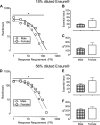Sex differences in opioid reinforcement under a fentanyl vs. food choice procedure in rats
- PMID: 30818323
- PMCID: PMC6898628
- DOI: 10.1038/s41386-019-0356-1
Sex differences in opioid reinforcement under a fentanyl vs. food choice procedure in rats
Abstract
Clinical evidence suggest that men are more sensitive than women to the abuse-related effects of mu-opioid agonists. In contrast, preclinical studies suggest the opposite sex difference. The aim of the present study was to clarify this discrepancy using a fentanyl vs. diluted Ensure® choice procedure to assess sex differences in opioid reinforcement. Sex differences in intravenous (IV) fentanyl self-administration were examined under a fixed-ratio (FR5) schedule, a multi-day progressive-ratio (PR) schedule for behavioral economic analysis, and a concurrent (choice) schedule of fentanyl and diluted Ensure® reinforcement in Sprague-Dawley male and female rats. The fentanyl dose-effect function under the FR5 schedule was significantly shifted upward in females compared to males. Similarly, the reinforcing effectiveness of both fentanyl (3.2 and 10 µg/kg per injection, IV) and diluted Ensure® (18 and 56%) were greater in females than in males as assessed using behavioral economic analysis, irrespective of dose or concentration. However, under a fentanyl vs. foodchoice procedure, males chose 3.2 µg/kg per injection fentanyl injections over 18%, but not 56%, diluted Ensure® at a higher percentage compared to females. Overall, these results suggest that the expression of sex differences in opioid reinforcement depends upon the schedule of reinforcement and that preclinical opioid vs. food choice procedures provide a translationally relevant measure (i.e., behavioral allocation) consistent with the direction of sex differences reported in the clinical literature.
Figures




Comment in
-
Capturing the complexity of sex differences requires multidimensional behavioral models.Neuropsychopharmacology. 2019 Nov;44(12):1997-1998. doi: 10.1038/s41386-019-0424-6. Epub 2019 Jun 4. Neuropsychopharmacology. 2019. PMID: 31164710 Free PMC article. No abstract available.
Similar articles
-
Conjugate vaccine produces long-lasting attenuation of fentanyl vs. food choice and blocks expression of opioid withdrawal-induced increases in fentanyl choice in rats.Neuropsychopharmacology. 2019 Sep;44(10):1681-1689. doi: 10.1038/s41386-019-0385-9. Epub 2019 May 2. Neuropsychopharmacology. 2019. PMID: 31043682 Free PMC article.
-
Effects of pharmacological and environmental manipulations on choice between fentanyl and shock avoidance/escape in male and female rats under mutually exclusive and non-exclusive choice conditions.Neuropsychopharmacology. 2024 Dec;49(13):2011-2021. doi: 10.1038/s41386-024-01939-7. Epub 2024 Aug 5. Neuropsychopharmacology. 2024. PMID: 39103498 Free PMC article.
-
Effects of kappa opioid receptor agonists on fentanyl vs. food choice in male and female rats: contingent vs. non-contingent administration.Psychopharmacology (Berl). 2021 Apr;238(4):1017-1028. doi: 10.1007/s00213-020-05749-9. Epub 2021 Jan 6. Psychopharmacology (Berl). 2021. PMID: 33404739
-
Comparison of the reinforcing, antinociceptive, and respiratory depressant effects of prototypical and G-protein biased mu-opioid receptor agonists in male and female Sprague-Dawley rats.Psychopharmacology (Berl). 2024 Dec;241(12):2453-2469. doi: 10.1007/s00213-024-06690-x. Epub 2024 Sep 27. Psychopharmacology (Berl). 2024. PMID: 39333403
-
Insights from Preclinical Choice Models on Treating Drug Addiction.Trends Pharmacol Sci. 2017 Feb;38(2):181-194. doi: 10.1016/j.tips.2016.11.002. Epub 2016 Dec 2. Trends Pharmacol Sci. 2017. PMID: 27916279 Free PMC article. Review.
Cited by
-
Magnitude and predictors of elasticity of demand for morphine are similar in male and female rats.Front Behav Neurosci. 2024 Aug 29;18:1443364. doi: 10.3389/fnbeh.2024.1443364. eCollection 2024. Front Behav Neurosci. 2024. PMID: 39267985 Free PMC article.
-
The kappa-opioid receptor agonist, nalfurafine, blocks acquisition of oxycodone self-administration and oxycodone's conditioned rewarding effects in male rats.Behav Pharmacol. 2020 Dec;31(8):792-797. doi: 10.1097/FBP.0000000000000581. Behav Pharmacol. 2020. PMID: 32804774 Free PMC article.
-
Drug versus non-drug behaviors: A dual-reward model of sex differences and neurobiological mechanisms in rats.J Exp Anal Behav. 2022 May;117(3):457-471. doi: 10.1002/jeab.752. Epub 2022 Mar 17. J Exp Anal Behav. 2022. PMID: 35297047 Free PMC article.
-
Anterior cingulate cortex and its projections to the ventral tegmental area regulate opioid withdrawal, the formation of opioid context associations and context-induced drug seeking.Front Neurosci. 2022 Aug 5;16:972658. doi: 10.3389/fnins.2022.972658. eCollection 2022. Front Neurosci. 2022. PMID: 35992922 Free PMC article.
-
Effects of sex and estrous cycle on intravenous oxycodone self-administration and the reinstatement of oxycodone-seeking behavior in rats.bioRxiv [Preprint]. 2023 Jun 6:2023.06.02.543393. doi: 10.1101/2023.06.02.543393. bioRxiv. 2023. Update in: Front Behav Neurosci. 2023 Jul 03;17:1143373. doi: 10.3389/fnbeh.2023.1143373. PMID: 37333293 Free PMC article. Updated. Preprint.
References
-
- Blue Cross and Blue Shield. America’s opioid epidemic and its effect on the nation’s commercially-insured population; 2017. https://www.bcbs.com/the-health-of-america/reports/americas-opioid-epide....
Publication types
MeSH terms
Substances
Grants and funding
LinkOut - more resources
Full Text Sources
Other Literature Sources
Research Materials

